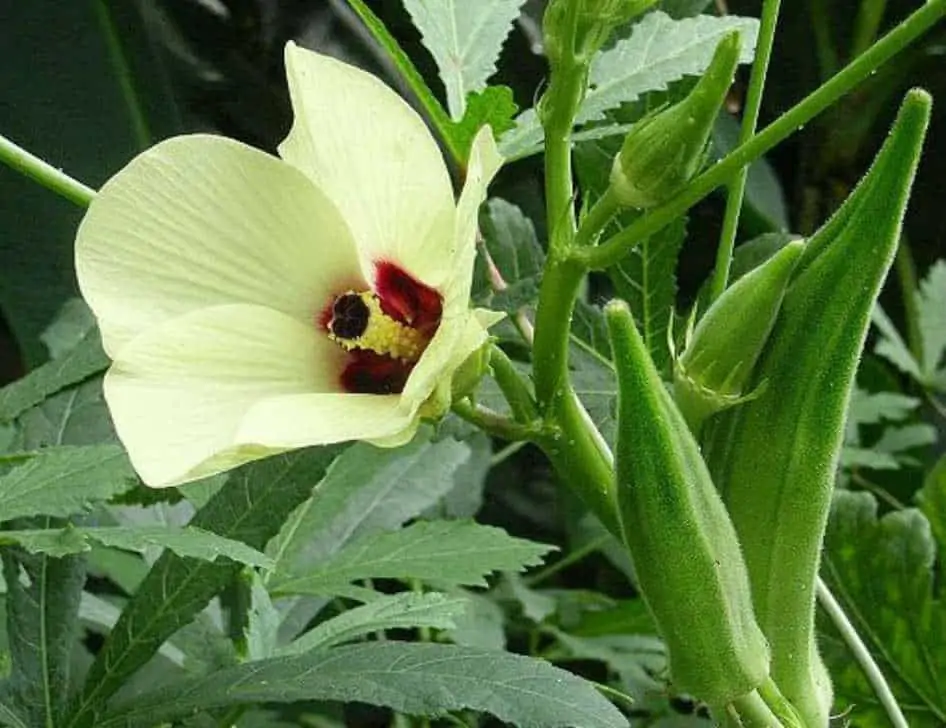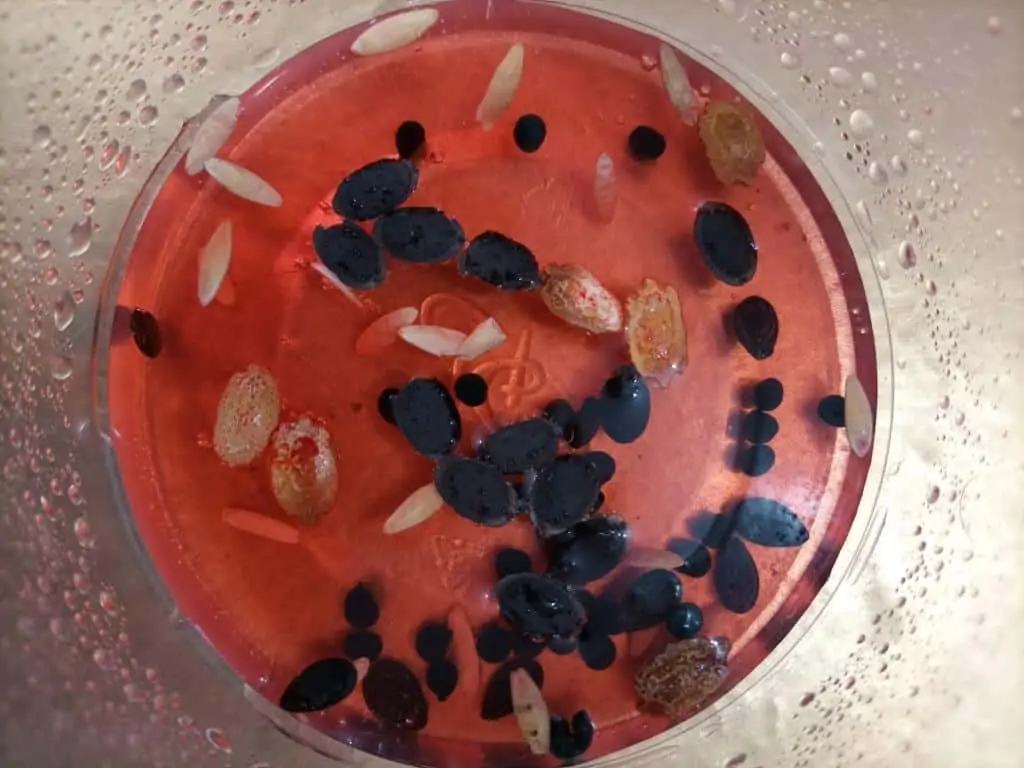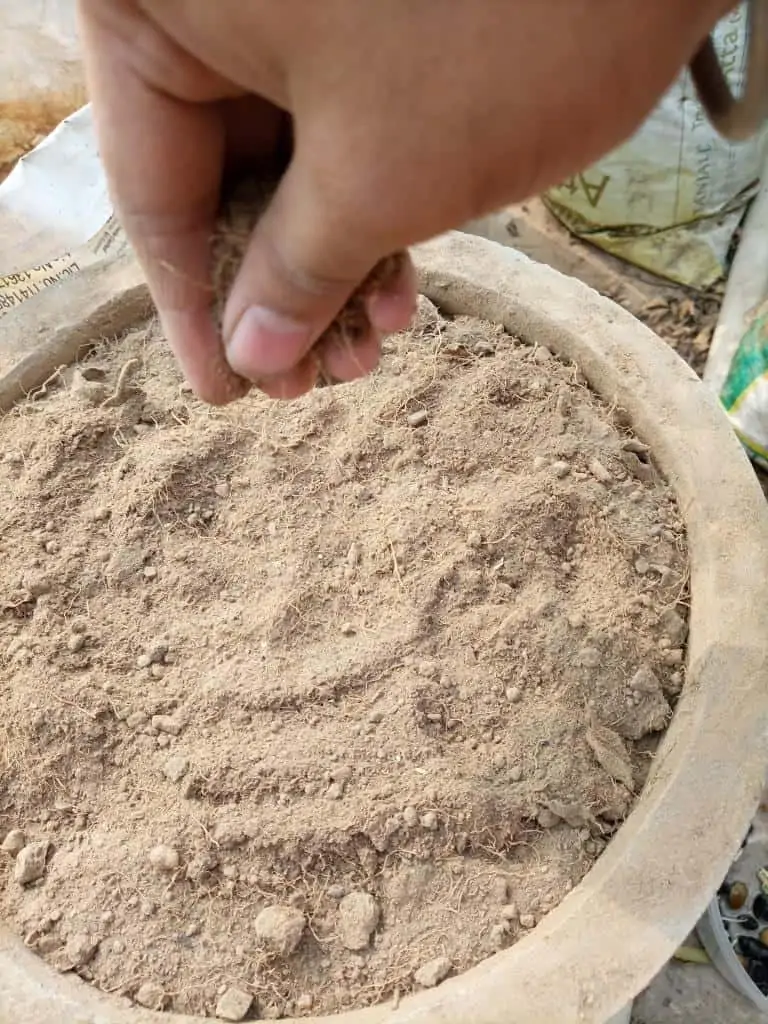Okra is a delicious vegetable. I think we all know that, or at least most of you may know what is Okra? Still, For a glimpse, I would say- Okra is a green, healthy finger-like vegetable. It is an edible green seed pod. That’s why it is known as Ladyfinger or ‘Ladies Finger’. It is a flowering plant that relates to the Hibiscus family. Today I will share my experience of growing Okra in Container.
| Common Name: Okra, Okro, Ladyfinger or ladies finger, Bhindi, Bheindi, Ochro
Native Climate: Tropical Warm Climate Scientific name: Abelmoschus esculentus Nutrients Composition: Protein 1.9g/100g, Vitamin A, Vitamin C, Vitamin B-6, Potassium, Sodium, Magnesium, and Calcium. |
It is an easy-to-grow vegetable that anyone can try. Before proceeding, lets us first discuss Why you should grow Okra in your Kitchen Garden? Also, check out my previous post- How to Grow and Care Mortgage Lifter Tomato?- Kitchen Garden

Three Reasons Why you should grow Okra in your Kitchen garden
- Okra is a very healthy and Tasty Vegetable. It contains lots of Vitamins and the least amount of digestible fat. This is ideal for a low-fat diet.
- It is green nutritious as well as very tasty and versatile in cooking. You can make a ton of delicious cuisine with fresh Okra. My favorite is deep-fried spicy Okra, Yes I know it is not super healthy but I like it this way.
- Okra is a fast-growing and easy-to-maintain plant. An Okra plant can start flowering in just 30-40 days of seed sowing. You can start harvesting Okra from the 50th day of germination. It will keep fruiting till it dies in the fall. Just 6-10 plants are enough to feed a family of four. You can harvest twice or sometimes thrice every week.
The convenience of growing your own food is the best advantage of having a kitchen garden. Okra is an addon to support the continuous supply of fresh easy to grow vegetables. Keep reading if you like fresh okra on your plate.
Do you know- Is Okra Fruit or Vegetable?
Identifying an Edible Okra
| Plant Size: Variable- 2 to 7 feet (25-80 inches)
Flower Size: 2-4 inches in diameter. Each Okra flower has five petals fused at the center. Flower color: Beautiful Light Yellow Flower with dark Red center. Fruit Size: 3-6 inches. 3-4inch Okra is ideal for harvesting. Fruit Color: Green and Red color variants are available. Both of them have similar grassy Taste. Leaf: Okra leaves are long broad and Palmated. Each leaf is 4-8 inches long with 5-7 palm blades or lobes. Healthy okra leaves are dark green and crunchy in texture. Root System: Okra Plant has a central Taproot with a supporting fibrous root system. Growing Season: Summer is the ideal growing season for Okra. Okra Seed can be sown in spring, 2 weeks after the last frost. Water Requirement: Moderate to Heavy. Watering should be regulated according to the humidity and temperature of the soil. Fertilization: Heavy Feeders. Leaf mold and compost are ideal for Okra plants. An (NPK )fertilizer low in Nitrogen and relatively high in Potassium and phosphorus are essential for flowering and fruiting in Okra plants. Harvesting: Okra fruits are basically green seed pods. They get ready to harvest in just 3-5 days. It will turn chewy and hard If you let it mature for just 2 more days. A healthy edible Okra should be soft short and easily breakable. It should not be hard fibrous and Chewy. |
Ok after this brief discussion let us come to the topic of discussion- How to grow okra especially in a container or a pot? Is it really possible? Just follow the Discussion, If you are curious to know some more facts.
Can Okra Grow in Pots or Containers?
Yes, almost every variety of okra can be grown in containers. Some varieties are tall while others are short. If you have a container of the required size then you are good to go. The size requirement may vary from one okra variety to another.
Okra is one of the easiest vegetables to grow in containers. It doesn’t require any extra preparation like growing a seedling. You can directly sow okra seed in a decent size container.
Can You grow Okra in a 5-gallon bucket?
A 5-gallon container or pot is enough to grow an Okra plant. I personally recommend growing dwarf varieties of okra in containers smaller than 10-15 gallons.
Tall varieties of okra need strong root support. A 5-gallon container is not enough strong to keep the plant in place. Sometimes you can have difficulties growing okra in a small 5-gallon container.
The soil can quickly dry and you may have to water frequently to these small containers. Otherwise, a 5-gallon container is enough to grow a healthy Okra plant. It just needs a little care.
What size of the container is good for Okra?
You can start growing okra in a small 10-inch pot. This is a possible but not a good option for a healthy yield. I have tried it successfully but the yield is below average. Also, the life span of that specific plant is very less compared to plants grown in bigger containers.
Actually, you should use at least a 5-gallon container to grow okra. This will allow the taproot to grow deep and helps the plant to attain proper height. After several hit and miss, I learned that a 10-15 gallon container or bucket is always best for most Okra varieties.
Technically, The container or grow bag should be at least 6-inch wide and 10-12 inches deep for a dwarf Okra variety. Choose a container that is at least 15 inches deep for optimum yield.
I know that you want to keep the container small, you can do that but it will need extra regular care for watering, fertilizing, and other support.
| Container Size For Dwarf Variety: 10-12 inch pot or container. 5-10 –gallon grow bag or buckets.
Container Size For Other Varieties: 12-15 inch pots or Containers. 10-15 gallon container or buckets. The minimum height of the container should be 12 inches or 1 foot for growing any variety of Okra. Okra plants develop a central Taproot. Therefore the depth of a container or grow bag is an essential factor in growing these vegetables. |
How many Okra plants can be grown in a 5-gallon bucket?
For Best Results, you should only grow 1 Okra plant in a 5 or 10-gallon bucket. You should start by sowing 2 or 3 healthy okra seeds in these containers. Let them germinate and grow up to 4 inches.
Latter you can thin out extra plants, leaving only one healthy and strong Okra plant in each Container. If you are ready to compromise with the yield then you can grow 2 of them in each pot. But not more than that. Bigger pots of 10-15-gallon can accommodate 2 plants easily.
Even 2 okra plants will double the requirement of water and fertilizer per pot or container. Also, the number and size of okra fruits will reduce accordingly.
Identifying Okra Seeds
You can easily identify Okra seeds. These seeds are small round and black in color. Each okra seed is just 2 to 3mm in size. It weighs 0.1 gram per seed or a little bit more or less. Generally, you will get 100 or more seeds in a 10-gram seed pack.

Each mature Okra seedpod contains 40-100 viable seeds. These seeds are arranged in five equal compartments. The best ones are complete round, and firm. The immature seeds generally get shrunk while drying. They can be easily identified among healthy mature seeds.
The okra seed is covered with a hard brown-black shell that protects the embryo from external factors. Okra seeds are dicotyledons. It allows the seed to be separated easily into two halves. These two halves are called cotyledons. They protect the baby plant embryo and also nourishes it until it starts producing its own food.
Selecting best Quality Okra Seeds
You should always select the best quality of okra seeds for growing. The selection of a good variety is the most essential part. The seeds should be selected to get maximum yield with minimum effort.
This can only be regulated by understanding four important factors. These are-
- Local Environment
- Available space
- Harvesting period
- Resource required
- You try these okra seeds for the best results.
The local environment plays an important role. It is a well-known fact that okra loves a warm humid climate. If it is favorable then you are good to go. Otherwise, you should choose only a native okra variety that is more tolerant to local climatic conditions.
Okra plants are very versatile and adaptive to minor changes in space and surroundings. Still, for best results, I will recommend choosing Dwarf Okra variety for containers and low vertical garden spaces.
Most Heirloom varieties can have a long harvesting season while hybrid varieties of Okra are more determinant with short growing seasons. These are suitable for high yields, especially in short summer zones. On the other hand, heirloom varieties are more tolerant to local climate and pests.
Obviously, resources like water and fertilizer are essential for growing okra. But the need for these resources is not the same for different okra varieties. A tall variety of okra needs more water and fertilizer as compared to Dwarf varieties.
you should consider all these factors before purchasing any okra seed. Also, you must check for the credibility of seed sellers especially in the case of heirloom okra seeds.
Popular Okra Varieties
Check the okra seed price on Amazon |
Steps to Check viability of Okra Seeds
There is a very simple and generations-old technique to check the viability of okra seeds. Most commercial farmers still use these techniques to determine the selection of the best quality healthy seeds.
- Start with looking for any shrunk or deformed seeds. Remove any light-colored, broken, shrunk, or deformed seeds. These seeds are mostly useless. Sometimes few of the discarded seeds can germinate but the chance of them developing into a healthy plant is negligible.
- Next check the selected healthy seeds for the sink test. Simply you can take a bowl of water and put all the okra seeds in it. All the healthy seeds will immediately sink while the bad ones keep floating. Just remove all the floating seeds and let the others soak for 24-36 hours before sowing.
How to Grow Okra in Containers?
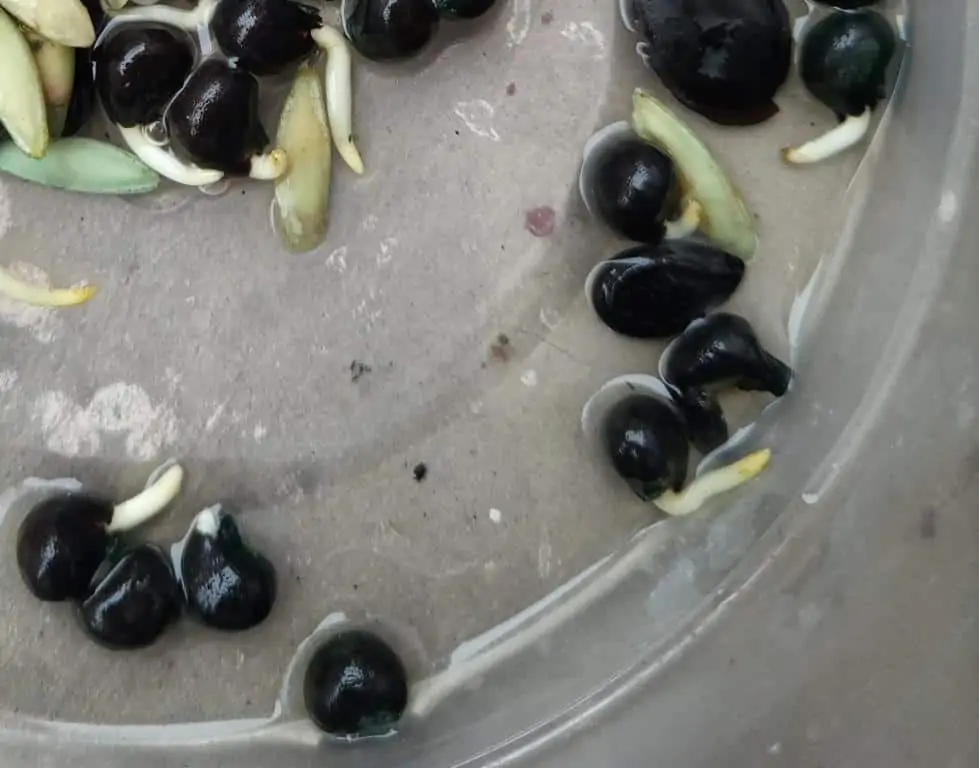
- Start with soaking the seeds for 24-36 hours. You can easily sort out the damaged seeds in this process.
- Next Prepare the soil mix for containers. Okra needs well drainage high nutritious soil mix. You can purchase a vegetable soil mix or prepare your own mix. I generally use 40% garden soil, 30% compost, 20% cocopeat, and 10% sand and perlite. You adjust this ratio according to the availability of resources.
- Directly sow 2-3 seeds in each container. Keep the seeds in the center. Cover them 0.5-1 inch with the same soil mix and water abundantly. You can also make a 1-inch hole and place the seeds inside them.
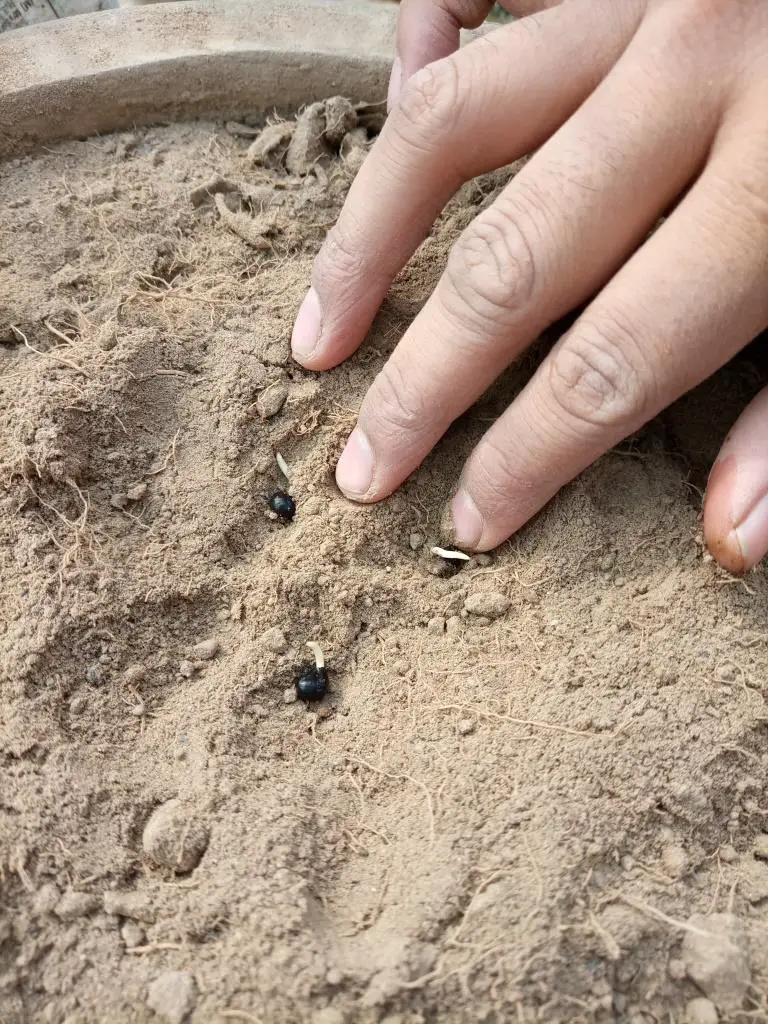
- The okra seeds will start germinating in 5-7 days. The rate of germination is affected by temperature and moisture. Always try to keep the soil warm and moist. This will encourage faster germination.
- Let the seedlings develop and grow up to 3-4 inches high. Then, Remove the smaller, unhealthy ones leaving just one okra plant in each container.
- Okra is a fast grower and requires lots of nutrition. So keep the plants fertilizing regularly, at least once in 15 days.
- Watering should be done in regular intervals. Okra is a summer vegetable therefore it requires enough water to survive the hot days. If the temperature is above 35 degrees Celsius then you have to water twice every day. Else water only when soil becomes dry.
How to Plant Okra in Containers?
Planting okra in the container is quite easy. It needs some extra care but most of us can do that. The only difference with container gardening is extra support and frequent watering.
This is inevitable, soil in containers dries up quickly. So to keep the plant hydrated you should keep the soil moist.
Another important consideration for container gardening is the proper temperature. You should sow the seeds only when the night temperature is above 15-18 degrees Celcius or above 55 Fahrenheit.
Flowering in Okra Occurs at a temperature above 22 degrees Celcius or 80 degrees Fahrenheit. Fertilization is also a very important aspect of vegetable gardening. Try to use more organic compost and least chemical fertilizers and pesticides. This will keep the veggies fresh and healthy for consumption.
Can you transplant Okra seedlings?
Technically, Yes you can grow and transplant okra seedlings but this is not very practical in commercial practice. The biggest problem with this approach is the Taproot system of okra.
If the main taproot gets damaged while transplanting then either the plant will die or get shunted with no flower or fruits.
It will require precise handling of a few of those decomposable seedling trays. You can place the whole tray with growing media and the seedling in the desired container. Then only you can think of any chance of successful growth. But this is not a feasible option for 100s or even 1000s of okra plants.
Therefore, you should follow the general norms, just sow the okra seeds directly into the containers.
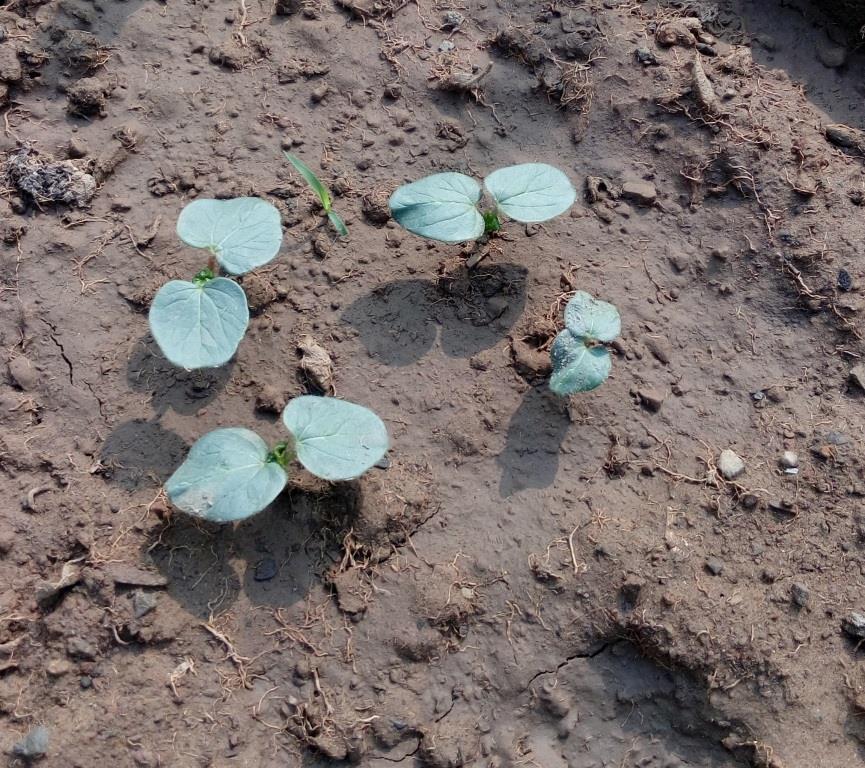
Caring Okra Plants in Containers?
Plants in containers indeed need extra care. You should be careful with proper support, water supply, nutrition, and pest control.
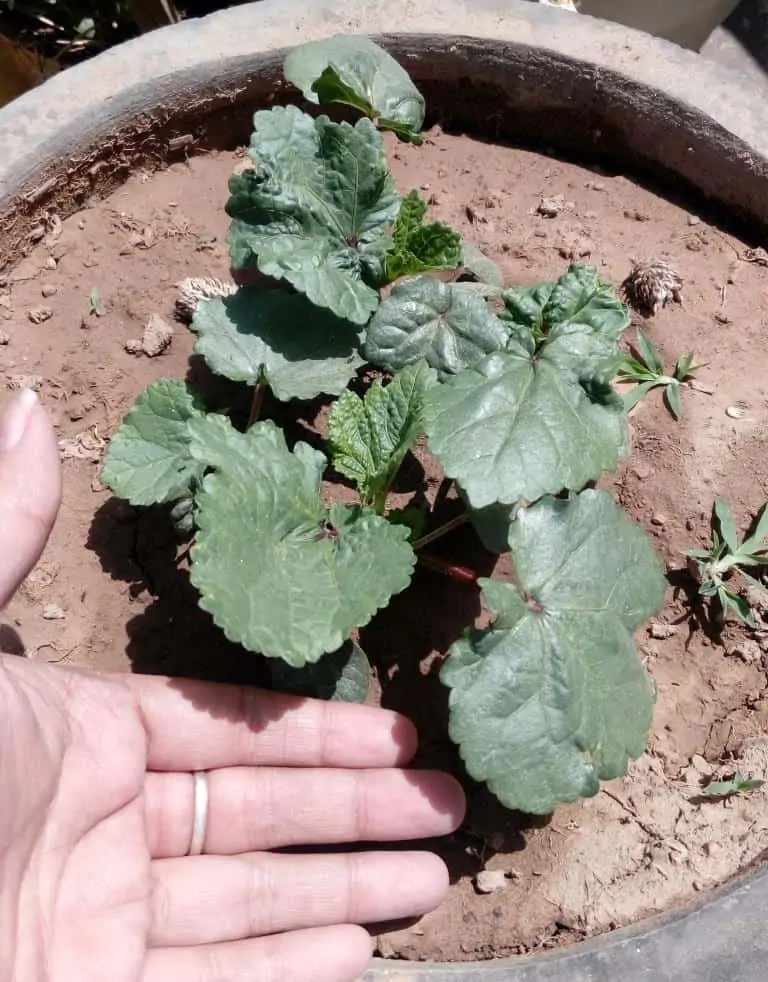
- Start with treating the seeds with antifungal powder. You should mix a pinch of fungicide into the water before soaking the okra seeds. It will protect the seed and the seedling from any fungal attack.
- Place the Okra plants in full sun from day 1 of their life cycle. Okra is a summer plant and the temperature will help in faster growth.
- Generally, okra plants don’t need any support. But I would recommend putting support sticks in containers, especially for tall okra varieties. Hot windy summer days can quickly dry the soil and the wind can turn the plants down. So a small support stick can save all your efforts.
- Never forget to water the plants. Okra plants need lots of water to develop flowers and fruits. If you let the plant dehydrate especially during the flowering period it will shed all the buds to protect itself.
- Meanwhile don’t forget to remove any weed or grass from the container. They can consume the nutrients and water intended for the okra plants.
- Add extra mulch and compost to keep the moisture and nutrition balanced. The soil can dry up quickly and mulching can prevent this water loss. Extra Compost on the top will feed the plants slowly with essential nutrients.
- For better yield, you can use low Nitrogen, high potassium, and Phosphorus based fertilizer. You can also use NPK 6:32:18 or Simple NPK:19:19:19 once in 10 days. This chemical fertilizer can quickly feed you okra plants. Always use it in prescribed quantity, a little extra can burn your plants. The difference can be observed within days.
- Never let the okra fruits mature unless you want to collect seeds from them. The seed pods will become hard and chewy. You cannot eat it like that. So Harvest the seedpods as soon as they become 3-4 inches long.
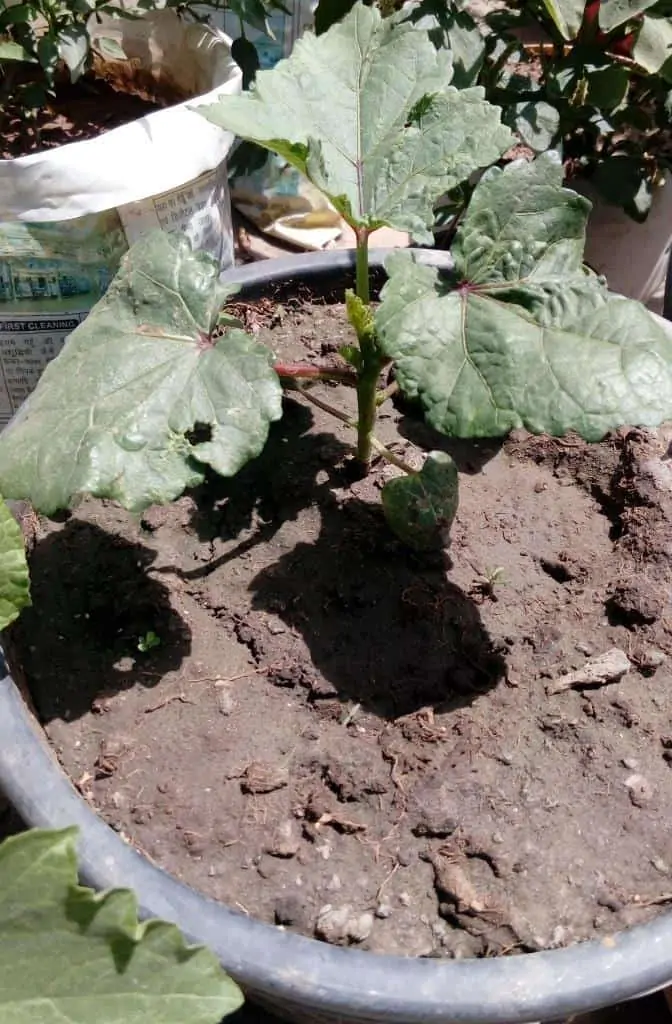
Common Problems with Okra Plants
You may have to face some problems with okra plants, especially in containers. Overwatering and Underwater is the primary source of all these problems.
Some of the Common problems with okra plants are-

- Pests and insect attacks: Aphids, spider mites, mealybugs, Beetle grubs, Caterpillars, and leaf borders are common pests for okra plants.
- Fungal and Bacterial Attacks: Brown-black patches, dry tips, deformed seedpods, and rotten roots and tips are common with fungal and bacterial growth.
- Shunted growth: This is a common effect of over or under-fertilization. Sometimes it is accompanied by other problems like pests or fungal attacks. Curling, shortening, and hardening of leaves is a common symptom.
Most of these problems can be controlled by regulating the water cycle. Overwatering is responsible for increased pests and insect attacks. It will be followed by a fungal attack. The damaged portion of stem and leaf and abundance of moisture and heat will attract fungal growth.
Underwatering is somehow less damaging than Overwatering. So avoid it as much as you can. Similarly never overfeed the plants especially with chemical fertilizers. It will disturb the natural growth pattern of the okra plants.
The control of all these problems just regulates the water and fertilization cycles. If the problem still there then use neem oil and soap solution to get rid of it. The use of chemical pesticides is the last option and I don’t like using those in my vegetable plants.
Flowering Schedule and Harvesting Okra
Okra plant should start flowering within 50-60 days of germination. It will keep fruits till it dies in the winter. The average fruiting season of okra is 90-120 days once it starts flowering. Above all the local climate greatly affects this cycle.
If your garden gets a long warm summer then you can harvest up to 150 days. While others may have just 60-90 days of the okra harvesting season.
This is why I recommend Hybrid varieties in short summer zones. It will help you in getting maximum yield in a short duration. Some heirloom varieties can also do so if grow with proper care and timing.
How to Harvest Okra?
- Use a Sharp Knife to cut off the seedpods.
- Don’t try to pluck it with a bare hand. It contains tiny hairlike spines and can irritate.
- pluck only small or medium-sized okra. It should be at most 3-4 inches long, anything longer than that will not taste good. Though some people like having bigger 5-7 inch long hard chewy okra in their stews, Maybe you can try some of that.
- To collect seeds leave only a few of the last seedpods at the end of the season. Never let the seedpod mature early in harvesting season. Your plant will not fruit likely after producing mature seedpods.
Please write your suggestion or any queries in the comment section. Share your experience of growing okra in containers.
Before leaving check out How to Grow and Care Beefsteak Tomato?- Kitchen Garden

